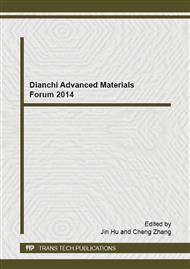[1]
G. A. Smolenskii and V. A. Isupov, Zh. Tekh . Fiz. 24 (1954) 1375.
Google Scholar
[2]
A. J. Bell, J. Phys. Condens. Matter 5 (1993) 8773.
Google Scholar
[3]
S. -E. Park and T. R. Shrout, J. Appl. Phys. 82 (1997) 1804.
Google Scholar
[4]
K. Uchino, Piezoelectric Actuators and Ultrasonic Motors. Kluwer Academic, Boston, (1996).
Google Scholar
[5]
Z. Yu, C. Ang, R. Guo, and A. S. Bhalla, J. Appl. Phys. 92 (2002) 2655.
Google Scholar
[6]
A. A. Bokov, M. Maglione, and Z. -G. Ye, J. Phys.: Condens. Matter 19 (2007) 092001.
Google Scholar
[7]
V. V. Shvartsman, J. Zhai , W. Kleemann, Ferroelectrics, 379 (2009) 77.
Google Scholar
[8]
K. Uchino and S. Nomura, Ferroelectr. Lett. Sect. 44 (1982) 55.
Google Scholar
[9]
H. Vogel, Z. Phys. 22 (1921) 645; G. Fulcher, J. Am. Ceram. Soc. 8 (1925) 339.
Google Scholar
[10]
A. A. Bokov and Z. -G. Ye, Phys. Rev. B 74 (2006) 132102.
Google Scholar
[11]
A. R. Akbarzadeh, S. Prosandeev, E.J. Walter, et al., Phys. Rev. Lett. 108 (2012) 257601.
Google Scholar
[12]
X. Yao, Z. L. Chen, L.E. Gross, J. Appl. Phys. 54 (1983) 3399.
Google Scholar
[13]
G. Burn and F. H. Dacal, Ferroelectrics 104 (1990) 25.
Google Scholar
[14]
L. Xie, Y. L. Li, R. Yu et al., Phys. Rev. B 85 (2012) 014118.
Google Scholar
[15]
J. Toulouse, B. E. Vugmeister, and R. Pattnaik, Phys. Rev. Lett. 73 (1994) 3467.
Google Scholar
[16]
V. Westphal, W. Kleemann, and M. D. Glinchuk, Phys. Rev. Lett. 68 (1992) 847.
Google Scholar
[17]
R. Blinc, A. Gregorovic, B. Zalar, et al., Phys. Rev. B 63 (2000) 024104.
Google Scholar
[18]
B. E. Vugmeister and M. D. Glinchuk, Rev. Mod. Phys. 62 (1990) 993.
Google Scholar
[19]
H. Frohlich, Proc. R. Soc. London, Ser. A 223 (1954) 296.
Google Scholar
[20]
R. E. Peierls, Quantum Theory of Solids, Oxford University, New York/London, (1955).
Google Scholar
[21]
P. A. Lee, and T. M. Rice, Phys. Rev. B 19 (1979) 3970; P. A. Lee, T. M. Rice, and P. W. Anderson, Phys. Rev. Lett. 31 (1973) 462; Solid State Commun. 14 (1974) 703.
Google Scholar
[22]
G. Gruner, L. C. Tippie, J. Sanny, W. G. Clark, and N. P. Ong, Phys. Rev. Lett. 45 (1980) 935; G. Gruner, A. Zawadowski, and P. M. Chaikin, ibid. 46 (1981) 511; G. Gruner, W. G. Clark, and A. M. Portis, Phys. Rev. B 24 (1981) 3641.
Google Scholar
[23]
V. V. Shvartsman and D. C. Lupascu, J. Am. Ceram. Soc. 95 (2012) 1.
Google Scholar
[24]
S. Brazovskii and T. Nattermann, Adv. Phys. 53 (2004) 177.
Google Scholar
[25]
A. Larkin, S. Brazovskii, Solid State Commun. 93 (1995) 275.
Google Scholar
[26]
S. Brazovskiil and A. Larkin, Synthetic Met. 86 (1997) 2223.
Google Scholar
[27]
Z. Jing, C. Ang, Z. Yu, P. M. Vilarinho, and J. L. Baptista, J. Appl. Phys. 84 (1998) 983.
Google Scholar
[28]
D. Hennings and A. Schnell, G. Simon, J. Am. Ceram. Soc. 65 (1982) 539.
Google Scholar


